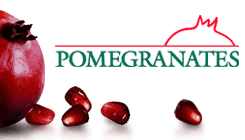 Where have these been all my life? I had never eaten a pomegranate "aril" before (an aril is a juice sack surrounding a nutritious seed...you eat the entire aril and get a burst of juice and a crunch of seed...it is truly amazing). Becky brought them to the chavurah last Saturday in a salad. I had seen the Velicks carefully extricating arils from a pomegranate last year and dismissed the entire process as too laborious. WHY DIDN'T I TASTE ONE?! Well, Becky made it easy and brought an "arils pre-separated" bowl...you can purchase the arils alone at the supermarket. Pomegranates are only available from September til January so they are WORTH THE HASSLE. After balking at the $5.99 arils-only container, I decided to brave it and purchase a $1 whole pomegranate. Luckily for me there is an entire website devoted to this fruit! It explains the 'easy way' to remove the arils from the fruit (no, it wasn't easy and it WAS messy, but I still think it was worth it.) This morning I sprinked some over my oatmeal- warm nutty oatmeal with cold juicy pomegrantes...I honestly beg you to try them.
Where have these been all my life? I had never eaten a pomegranate "aril" before (an aril is a juice sack surrounding a nutritious seed...you eat the entire aril and get a burst of juice and a crunch of seed...it is truly amazing). Becky brought them to the chavurah last Saturday in a salad. I had seen the Velicks carefully extricating arils from a pomegranate last year and dismissed the entire process as too laborious. WHY DIDN'T I TASTE ONE?! Well, Becky made it easy and brought an "arils pre-separated" bowl...you can purchase the arils alone at the supermarket. Pomegranates are only available from September til January so they are WORTH THE HASSLE. After balking at the $5.99 arils-only container, I decided to brave it and purchase a $1 whole pomegranate. Luckily for me there is an entire website devoted to this fruit! It explains the 'easy way' to remove the arils from the fruit (no, it wasn't easy and it WAS messy, but I still think it was worth it.) This morning I sprinked some over my oatmeal- warm nutty oatmeal with cold juicy pomegrantes...I honestly beg you to try them.I was curious as to the pomegranate's nutritional punch and found this here:
Why Eat It
The pomegranate, affectionately known as the "jewel of winter," has recently been acclaimed for its health benefits, in particular, for its disease-fighting antioxidant potential. Preliminary studies suggest that pomegranate juice may contain almost three times the total antioxidant ability compared with the same quantity of green tea or red wine. It also provides a substantial amount of potassium, is high in fiber, and contains vitamin C and niacin.
Used in folk medicine (to treat inflammation, sore throats, and rheumatism) for centuries in the Middle East, India, and Iran, the pomegranate is about the size of an orange or an apple. It has a tough, dark red or brownish rind. The seeds and the juicy translucent scarlet red pulp surrounding the seeds of the pomegranate are the edible parts of the fruit, although only the pulp has any flavor. Encased within a bitter-tasting, white, spongy, inedible membrane, the seeds can be gently pried out with your hands. Perhaps one of the reasons the pomegranate isn't as popular as it deserves is that it takes time and care to get to the seeds. The flavor of these juicy seeds is delicate, sweet, and tangy.
So, have I convinced you? What are you waiting for? Put it on your grocery list-you won't be disappointed!





1 comment:
OK ~ You have talked me into it! I will rush out and buy a pomegranate and see what we think of it. Have you tried pomegranate juice? I`ve seen it in cute little bottles labled POM.
PS ~ Does it stain your fingers?
Mom
Post a Comment